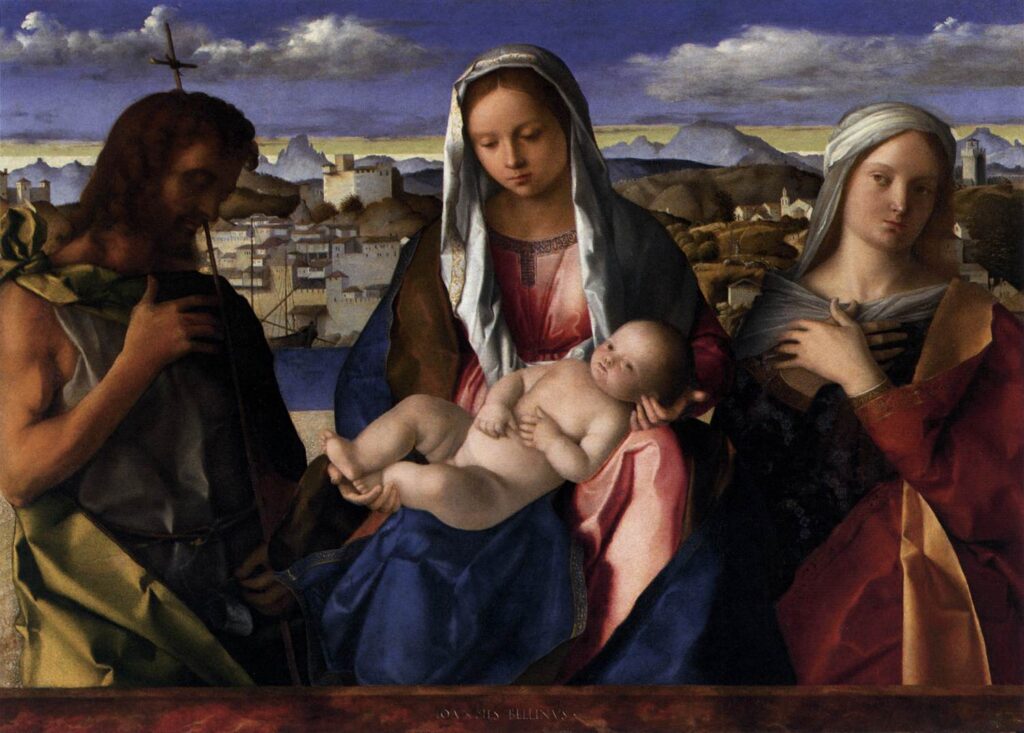
In today’s gospel passage, on seeing Jesus, St John the Baptist calls out “Behold the Lamb of God!” Although this scene is not shown very often in Western Art it has entered the iconography of the Baptist. For example, often St John the Baptist is shown pointing a finger towards Christ, or carrying a scroll bearing the Baptist’s words in Latin: “Ecce Angello di Dio.” In this painting by Giovanni Bellini St John the Baptist contemplates the Jesus as the Lamb Of God, but as you might expect from this artist, the symbolism is rather subtle. The Virgin holds the infant Jesus on her knee. He is a normal child. He looks strong and healthy. He looks as if he might be about to kick as babies sometimes do, but his mother’s gently holding hands keep him still. Her gaze is inward. Her stillness is focused on her child who looks outward towards the viewer and world. On the left St John the Baptist is easily recognised. In fact, he bears a strong resemblance to other contemporary depictions of the saint, most notably that of Cima da Conegliano at the Church of the Madonna dell’Orto (1493-5). Also he is dressed in what is more or less the same green garment, with that knot on the shoulder. He also is still and is deep in contemplation. Behind the figures there is a beautiful landscape. Both the figures in the foreground and the landscape are lit by the same light. The sun is low in the sky so that this must be either morning or late afternoon. Between the figures on the left, you can see a city on a river with a boat in its harbour and beyond it a fortress on a hilltop. The buildings are of a pale stone which catches the light and echoes the white headdresses. To the right you can see more buildings and a shepherd with his flock in a field. The location might be somewhere in the Veneto, but we know that, as in all of Bellini’s paintings, it is nowhere in particular. Yet, the distant peaks might be the Alps. In Bellini’s paintings, sometimes elements in the landscape have a symbolic meaning. The saint on the right has no identifying attribute. However, she inclines her head slightly, drawing our attention to a distant tower. Could this be St Barbara and the tower her attribute? It may not be her. Usually, she is shown holding a tower but such a device would be far too intrusive for Bellini. In this work there is a remarkably delicate harmony and balance which unifies the figures in the foreground and the landscape behind. But as exquisite as this scene is, it is only the backdrop. The central focus is on the infant Jesus. Now the child is naked. Usually, this was a way of drawing the viewer to contemplation of the Incarnation. God takes on human nature – the Word is made flesh. The naked child also suggests the Passion when the adult Jesus is stripped of his clothing on the cross. The child’s feet are crossed as might be those of any infant, but some have commented that this is how his feet will be positioned on the cross. It is Bellini intended us to see that the child and the man, Jesus the Lamb of God, is the object of the Baptist’s contemplation.
This type of painting wherein a number of saints are shown together has come be known as a Sacra Conversazione. Most often the saints bore no direct biographical links to each other. Saints were chosen for whom the patron had a special devotion or who were significant in some other way. Each saint is shown in contemplation. In Venice, altarpieces were often of this kind. They were large and the saints were shown in full-length. But Bellini’s and his workshop also produced numerous works for private devotion, including numerous half-length pictures of the Virgin and Child. In some saints were placed in contemplation on either side as in this work. But in the earlier works the figures were positioned either against the sky or darkness. It is thought that this is the first in which they are set against a full landscape. Of course, Bellini gives that landscape its own distinctive voice.
It is not known for whom or for where this painting was made. It is often referred to as the Giovanelli Sacra Conversazione because for over two centuries it was in the collection of the Giovanelli family in Venice. It wasn’t even attributed to Bellini, even though his name appears on the parapet at the bottom. In 1925, it was donated to the Accademia and was soon recognised definitively as from the hand of Bellini himself. It is dated to around 1501 on stylistic grounds and because of another painting in London’s National Gallery Collection which is thought to be based on this work. This painting is “The Virgin and Saints” by Andrea Previtali, who was a pupil of Bellini. It has a firm dating of 1504 and so by that year this work must have been completed.
The Catholic Chaplaincy serves the students and staff of the University of Edinburgh, Edinburgh Napier University and Queen Margaret University.
The Catholic Chaplaincy is also a parish of the Archdiocese of St Andrews and Edinburgh (the Parish of St Albert the Great) and all Catholic students and staff are automatically members of this parish.